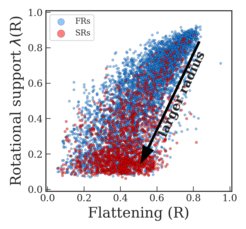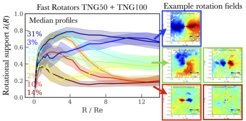The stellar halos of ETGs in the IllustrisTNG simulations: The photometric and kinematic diversity of galaxies at large radii
Pulsoni, C., Gerhard, O., Arnaboldi, M., Pillepich, A., Nelson, A., Hernquist, L., Springel, V., 2020, A&A, 641, A60

Observations and simulations of early type galaxies (ETGs) support a formation scenario in which they quickly form stars at early times and then grow in mass and size by accreating lower mass galaxies. Since the in-situ-born stars dominate in the galaxy central regions while the accreted stars mostly accumulate in the outskirts, a consequence of the two-phase assembly is that ETGs are expected to show variations of their physical properties with radius. Extended kinematic studies of ETGs unveiled the presence of variations in the kinematic properties between inner regions and halos, pointing towards changes in their intrinsic structure with radius (Pulsoni et al. 2018).
Using the IllustrisTNG cosmological simulations, we study the kinematic and intrinsic shapes of simulated ETGs and compare them to observations. Simulated ETGs reproduce the morphological richness of velocity fields at large radii found in observations. ETGs with fast rotating central regions (fast rotators, FRs) divide almost evenly in one third having rapidly rotating outskirts, a third with rotational support gently decreasing with radius, and another third with non-rotating outskirts (see Figure 1). ETGs with non-rotating centers (slow rotators, SRs) tend to increase rotational support with radius.
Changes in the kinematics are related to changes in the galaxy structure: transitions to lower rotational support are accompanied by changes towards rounder and more triaxial intrinsic shapes (see Figure 2).
Simulated FRs and SRs show a large variety of structural properties at large radii with significant overlap among the two families, despite the clear bimodality of their central regions.


